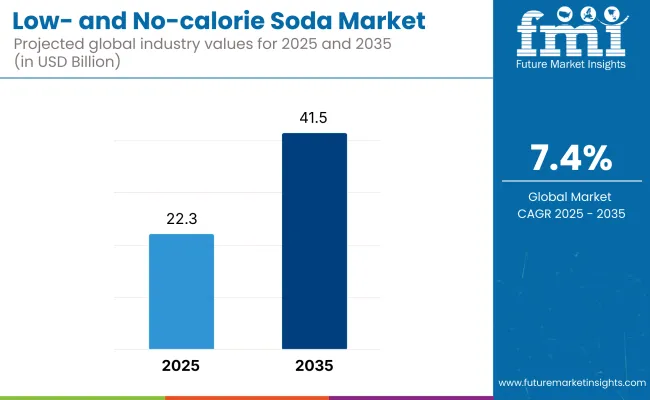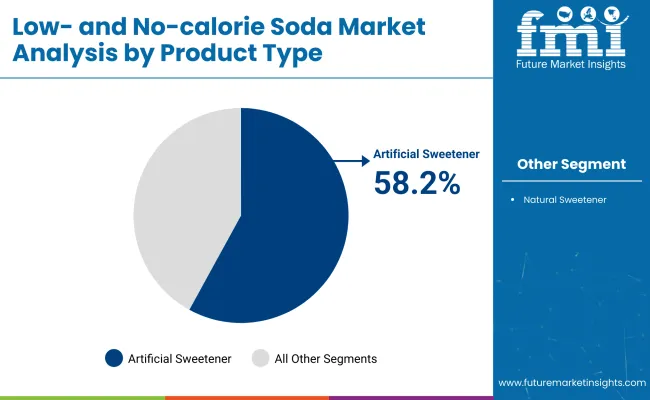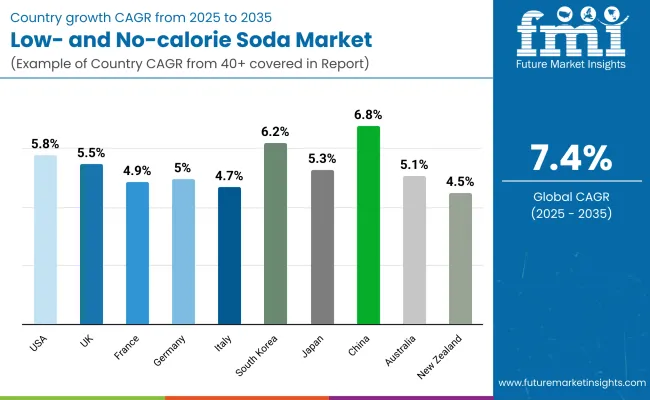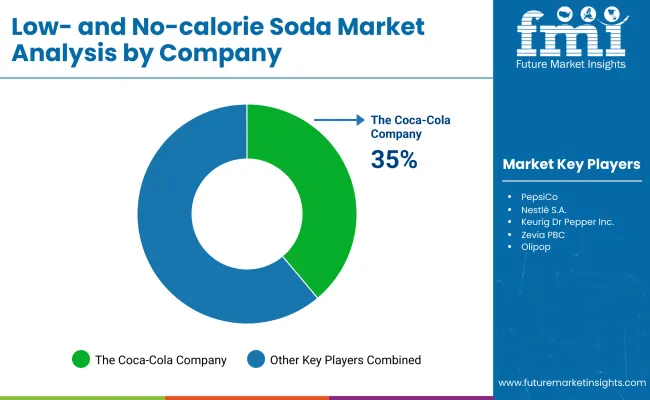The low- and no-calorie soda market is estimated to be worth USD 22.3 billion in 2025 and is projected to reach USD 41.5 billion by 2035, expanding at a CAGR of 7.4% over the assessment period 2025 to 2035.

The industry is a growing segment generated by the increasing consumer inclination towards healthier alternatives. The prevalence of sugar-related issues as well as the obesity and diabetes pandemics is leading consumers to seek out sugar and calorie-free soda alternatives. Following the industry demand, beverage manufacturers are making moves by combining natural sweeteners, functional ingredients, and the clean-label approach to appeal to health-conscious customers.
The key driving factor for this industry's rise is the emphasis on the trend of sugar reduction and the demand for wellness-centric dietary choices. People want drinks that taste just as good but have fewer or no calories compared to conventional sodas.
There has been a noticeable transition toward using plant-derived sweeteners such as stevia, monk fruit, and allulose as producers hunt to swap out the synthetic sweeteners that previously were found in products like aspartame and sucralose. The trend of functional and fortified sodas, which contains ingredients associated with health benefits, is also what contributes to this industry's growth.
Manufacturers have started introducing low- and no-calorie sodas spiced up with vitamins, probiotics, and adaptogens alongside the trend of beverages that improve digestion, boost hydration, and provide energy. Ketogenic, low-carb, and intermittent fasting diets gaining more prominence also contribute to the overall increase in demand for sugar-free soda alternatives.
Discoveries in beverage blending and carbonation technology that lead to better drinking and wider enjoyment of the product by the customer are basically a boon for the sector. Firms are channelling their efforts in finding distinctive tastes and inventive systems of sweetening that will not leave the lingering aftertaste which is a popular complaint regarding certain syrups. Another factor in favor of the sector is the diversification of e-commerce platforms and consumer-oriented model also leads to boost user activity and product distribution.
Still, the industry is facing some difficulties like government rules opposing the use of artificial sweeteners, customers doubting the effectiveness of sugar-alternatives, and the presence of other similar low-calorie beverages like flavoured water and sparkling teas. Besides, finding the equilibrium between the taste, the price, and the use of clean-label components is the push factor for the producers.
Regardless of these impediments, the industry expansion potential is monumental. There is a rise in consumers' need for sustainable and environmentally friendly packaging together with the emergence of craft and premium beverage brands; this has led to the creation of new growth paths for inventiveness. As people keep giving more importance to health and well-being, the industry is set for an ongoing gain trend in the years to come.
Low- and no-calorie soft drink is witnessing robust growth driven by health-aware consumers, increasing obesity worries, and government action to restrict sugar consumption. Consumers' demand for natural and artificial sweeteners such as stevia, sucralose, and aspartame is influencing the product landscape as brands prioritize taste enhancement and clean-label products.
Within health-aware and diabetic consumers, sugar substitute quality and brand openness are the driving purchase factors. Low-calorie and functional drinks are the priority among athletes and gym-goers, with brands that contain electrolytes and supplemental nutrients being a preference. General consumers and restaurants favor taste and cost, with taste innovation and price competitiveness being vital industry drivers.
Sustainability is also a key consideration, with brands now favoring recyclable packaging and sugar substitutes derived from plants in order to meet eco-friendly trends. Future industry growth will be driven by innovations in carbonation, functional ingredients, and hybrid drink formats.
Below table illustrates a comparative assessment of CAGR shake-up for six months for base year (2024) and current year (2025) in the industry. The analysis reads into the continuity of industry performance, and the stakeholders can see the pattern of realization of revenue and growth pattern for the following year more clearly.
| Particular | Value CAGR |
|---|---|
| H1 (2024 to 2034) | 7% |
| H2 (2024 to 2034) | 7.2% |
| H1 (2025 to 2035) | 7.3% |
| H2 (2025 to 2035) | 7.4% |
In 2024, the industry recorded a 7% CAGR in H1 and then by more modest rise of 7.2% in H2. Entering 2025, the CAGR is anticipated to rise to 7.3% in the first half (H1) and soar at 7.4% in the second half (H2).
The industry increased consistently from 2020 to 2024 due to increasing demand for healthy drink items by consumers and increased awareness of the harmful impact on health through sugar consumption. Drink makers reformulated beverages to lower the sugar content, employing artificial and natural sweeteners such as stevia, aspartame, and sucralose to satisfy consumers' low-calorie needs.
Large beverage companies extended their portfolios with new flavors and functional ingredients such as vitamins, minerals, and probiotics to appeal to health-conscious consumers. Sugar taxes and health labeling standards for wholesome content, amongst other regulatory forces, further spurred manufacturers to innovate and adapt to changing industry drivers.
However, taste issues and sweetener concerns around artificial sweeteners were a damper on wider consumer embrace. From 2025 to 2035, the category will be revolutionized by innovation in natural sweeteners and functional ingredients that redefine consumer demand.
Plant sweeteners such as monk fruit and allulose will move further inwards based on their natural occurrence and engineered flavor profiles. AI-flavored engineering will allow complex sugar-free flavor profiles to be developed that precisely mimic the taste and texture of real sodas.
Functional low-calorie sodas with embedded adaptogens, electrolytes, and probiotics will become increasingly popular, blurring the line between beverages and health supplements. Green packaging and low-carbon manufacturing will be a key selling point as green-aware consumers are increasingly backing open environmental policy brands.
Comparative Market Shift Analysis 2020 to 2024 vs. 2025 to 2035
| 2020 to 2024 | 2025 to 2035 |
|---|---|
| Consumer demand-led growth for less sugar and healthier alternatives. | Emergence of plant-based sweeteners such as monk fruit and allulose. |
| Application of artificial and natural sweeteners such as stevia and aspartame. | AI-aided flavor development to enhance taste imitation. |
| Addition of functional ingredients like vitamins and probiotics. | Expansion of functional sodas with adaptogens and electrolytes. |
| Regulatory push of sugar levies and labeling requirements. | Green packaging and carbon-neutral production becoming the standard. |
| Taste apprehensions and lack of faith in artificial sweeteners. | Improved taste profiles and creativity in natural sweeteners driving wider acceptance. |
The industry is on its way up thanks to the climbing health consciousness and the customer's desire for sugar-free drinks. However, the strict rules on artificial sweeteners and the need for labelling transparency cause problems with compliance. The businesses have to abide by food safety norms and disclose the ingredients clearly to be able to keep their customers' trust and industry approval.
Supply chain disturbances, such as the increase in the prices of raw materials and the limitation of resources like stevia and monk fruit, can affect production costs and availability. The companies should widen their net of suppliers, finance the sustainable ingredient sourcing and work on assuring the stability of formulations as means of mitigating the supply-side risks.
The shift in the consumer's choice towards the products with natural and organic contents and away from beverages artificially sweetened is a blow for such drinks. The negative image of artificial sweeteners like aspartame and sucralose further reduces the possibility of sales in this industry.
Industry share and pricing strategies had to face a more serious challenge this time from the intense competition of functional beverages, flavoured sparkling water, and natural juice alternatives. To be able to compete unafraid brands should choose the way of distinguishing themselves by means of the combinations no one else has, gaining customer recognition through extra health perks and packaging that reduces the carbon footprint.
Industry conditions, like high inflation and alterations to the tax law on both sugary and diet drinks, are some of the factors that are likely to affect the beverage business environment. For the long run the firms better listen to the calls of innovations, seek out the right partnerships, and help educate the customers just to steer clear of the issues they can cause.

| Segment | Value Share (2025) |
|---|---|
| Artificial Sweeteners (Type) | 58.2% |
In 2025, the industry in terms of the artificial sweeteners segment held the largest industry share of about 58.2% due to the higher preference for these drinks among American consumers. Common non-sugar sweeteners such as aspartame, sucralose, saccharin, and acesulfame potassium are extensively included in diet sodas based on their potent sweetness and mere lack of calories.
Diet Coke and Pepsi Zero Sugar Millions of people still want classic sodas without the calories. Diet Coke and Pepsi Zero Sugar still need to use artificial sweeteners to simulate the old sugar, not content. The cost competitiveness and regulatory sanctions of artificial sweeteners (such as FDA and EFSA sanctions of aspartame and sucralose) are also a big factor in its dominance in the industry.
The Natural Sweeteners segment, which is dominating the industry, holding a 41.8% share, was the industry's fastest-growing component, owing to a spike in demand for clean-label and plant-based alternatives among consumers. Artificial sweeteners such as aspartame and sucralose are being replaced by natural sweeteners (like stevia or monk fruit extract) and erythritol.
Soft drink brands such as Zevia, Virgil’s Zero Sugar, and PepsiCo’s STARRY Zero Sugar have developed stevia-based formulas to appeal to consumers looking for naturally sweetened sodas. It has also launched Coke Life, which has stevia as its sweetener in addition to cane sugar, targeted to consumers looking for both natural-sourced ingredients and lower calorie counts.
As health-conscious consumers continue to seek non-GMO, organic, and plant-based sugar substitutes, natural sweeteners are predicted to capture a growing share of the sugar replacement industry. Yet, artificial sweeteners continue to be king because of their cheapness, taste consistency and mainstream diet soda usage.

| Segment | Value Share (2025) |
|---|---|
| Supermarkets/Hypermarkets | 50% |
With an over 50% share of the industry, the supermarkets/hypermarkets segment holds the top spot in 2025. Or large retailers like Walmart, Tesco, Carrefour, or Costco, with a strong presence, possibilities for bulk purchasing, and in-store promotions.
In comparison, the beverage industry is also dominated by supermarkets; consumers are much more likely to want to go to a store so they can feel the product, and compare prices and special in-store offers. Retailers also partner with beverage brands to provide discounts and promotional bundles, which contributes to increasing sales in that segment.
Online retail stores dominate the industry with a 30% industry share. This segment is rapidly growing due to the global perception of eCommerce platform stores like Amazon, Walmart+, grocery store delivery services, Instacart, and the like.
Home delivery, a broader array of brands and flavors, and personalized subscription models are fueling this trend. PepsiCo and Coca-Cola, for example, grew their direct-to-consumer (DTC) sales channels, which allow customers to order low- and no-calorie sodas from brand websites.
The growth of health-conscious customers who use digital media to explore ingredients and compare nutritional values is also fuelling the development of the online marketplace. Supermarkets remain the top channel for sales, but change is coming, as with e-commerce and digital grocery shopping, which are accelerating, particularly with the growing use of mobile shopping apps and same-day delivery services.

| Countries | Estimated CAGR (2025 to 2035) |
|---|---|
| USA | 5.8% |
| UK | 5.5% |
| France | 4.9% |
| Germany | 5.0% |
| Italy | 4.7% |
| South Korea | 6.2% |
| Japan | 5.3% |
| China | 6.8% |
| Australia | 5.1% |
| New Zealand | 4.5% |
The USA no- and low-calorie soda industry is projected to advance at a 5.8% CAGR during 2025 to 2035. There is increased awareness of obesity and diabetes, which is also serving as a driver for the industry, turning away consumers from typical high-sugar sodas.
Key beverage giants such as PepsiCo and Coca-Cola have moved their product lines by adding natural sweeteners in the form of stevia and erythritol. The need for functional drinks with added benefits, including probiotics and electrolytes, is also increasing, driving innovations in the category.
Direct-to-consumer platforms and online businesses have also made it possible for premium soft drink brands like Zevia and Olipop to reduce distribution beyond off-commute shelves. State-level usage of sugar taxes in America, such as in New York and California, has made it possible for the demand for healthier alternatives to increase. Finally, advancements in clean-label, plant-based liquid drink culture made naturally sweet soft drinks and additive-free favorites mainstream.
The UK industry is expected to record a CAGR of 5.5% during 2025 to 2035. The government taxation on sugar introduced via the Soft Drinks Industry Levy (SDIL) has been one of the most influential drivers in consumer form, creating demand and pressurizing manufacturers to make their products lower in sugar. In response, manufacturers such as Britvic and Fever-Tree have introduced a series of low-calorie and naturally sweetened soft drinks.
Shoppers are drawn to sparkling water and plant-based sodas with natural flavor and functional ingredients such as vitamins and minerals. The rising trend towards vegan and plant-based diets has also resulted in demand for sugar-free and clean-label drinks. New product development in the beverage category, including hybrid drinks that combine conventional sodas and herbal infusions, has also been popular among health-driven shoppers.
French industry is expected to grow at a CAGR of 4.9% during 2025 to 2035. Consumers in France favor premium, craft sodas made from natural ingredients, which has led the Lorina and La French Soda brands to concentrate on premium, low-calorie versions. The growing need for organic and clean-label drinks has led the manufacturers to remove artificial sweeteners and instead use natural sweeteners like agave and stevia.
Government attention to curbing sugar consumption through public health measures has been an essential impetus in altering the soft drink industry. Additionally, growth from the greater application of probiotics and plant extracts with functional beverages is boosting the development of the sector. French hypermarkets and specialist food retailing shops continue to expand their sales of healthier alternative soda drinks based on consumers' desire for new low-calorie beverages.
Germany's industry is projected to register a CAGR of 5% in 2025 to 2035. German consumers who are health-aware have embraced functional and naturally flavored soft drinks tremendously. Brands such as Bionade have ridden the trend by launching organic, sugar-free variants based on fermented products.
The growing popularity of sugar-free drinks has stimulated major soda corporations to launch naturally sweetened and low-calorie drinks. Retail chain expansion and online food shopping have also provided for easy accessibility of these drinks. Additionally, government regulations curbing the amount of sugar used in drinks will drive the transformation towards healthier soft drinks.
Italy's industry will grow at a CAGR of 4.7% from 2025 to 2035. Italian consumers also prefer naturally flavored soft drinks that are flavored using Mediterranean, and therefore naturally flavored soft drinks using citrus and herb extracts have increased in popularity. Lurisia and San Pellegrino have been offering their premium soft drinks with sugar-free and low-calorie options, keeping pace with changing consumer behavior.
The increasing trend toward healthier living, fueled by government and consumer campaigns, has boosted the consumption of products with less or no artificial ingredients. The sales growth in specialty stores and gourmet channels also increased the intake of clean-label, low-calorie sodas in Italy.
The South Korean no- and low-calorie soda industry is anticipated to expand at a CAGR of 6.2% during the period 2025 to 2035. The growing emphasis on beauty and health in the country has increased the demand for functional, sugar-free sodas with vitamin and collagen enrichment. Companies such as Lotte and Binggrae have launched innovative offerings with ginseng and herbal extracts.
The surge in convenience stores and online growth has given consumers easy access to healthier substitutes for soda. Carbonated beverages that are rich in health benefits are also being increasingly adopted by the younger generations, calling for ongoing product innovation.
Japan's no- and low-calorie cola industry is projected to expand at a CAGR of 5.3% during 2025 to 2035. Japan has a long history of functional drinks, and industry leaders such as Asahi and Suntory have introduced zero-calorie product brands in response to consumer demand.
Chinese consumers like consuming sodas that contain added functional ingredients like collagen, green tea extracts, and amino acids. This has seen the adoption of hybrid sodas with conventional carbonated beverages coupled with health-enhancing ingredients. Greater awareness of lifestyle diseases has accelerated the switch to sugar-free soft drinks even more.
The Chinese no- and low-calorie soda industry is expected to increase at 6.8% CAGR in 2025 to 2035. Rising middle-class incomes and urbanization have spurred demands for healthier beverages. Local companies such as Genki Forest are leading the industry with sugar-free bubbly drinks that have off-the-beaten-path flavors.
The growth of convenience store chains and online shopping websites has also focused on the distribution channel for low-calorie soda. Government wellness and health programs have also focused on consumer demand for zero-calorie drinks.
The industry in Australia will expand at a CAGR of 5.1% from 2025 to 2035. People are actually cutting back on sugar, so naturally sweetened sodas are in ever-growing demand. Sugar-free soft drinks with enhanced functionalities have come out of companies like Nexba.
The regulatory policies to limit the use of sugar and increasing demand for organic soft beverages have fueled the industry growth. The availability of specialty stores emphasizing healthy products has also increased the development of this segment.
New Zealand's low- and zero-calorie soft drink industry will grow at a 4.5% CAGR from 2025 to 2035. The country's health-conscious population is turning towards clean-label and naturally flavored soft drinks.
Local companies have shifted their production to low-sugar and organic carbonated soft drinks in an attempt to meet growing demand. Greater penetration by health-oriented food stores and online sites has heightened the availability of health-oriented alternative sodas.
The industry is growing rapidly because consumers are demanding more health-based options, possible reduction in sugar, and functional beverages. Signs that the regulatory scrutiny of sugar in products will sharpen even more are coupled with an increasing awareness of the need for clean-label, naturally sweetened, and functional drinks, thus changing the very competitive landscape.
Leading players like The Coca-Cola Company, PepsiCo, Nestlé S.A, Keurig Dr Pepper, and Zevia are now looking more into natural sweeteners (stevia, monk fruit) botanical infusion and innovative formulations in their products to keep pace with dynamic consumer Healthier versions of carbonated beverages, such as Coca-Cola's reformulated Coke Zero Sugar and PepsiCo's Bubly.
The novelty is the result of advances in sugar alternatives, increased demand for plant-based ingredients, and trends toward premiumization in the beverage industry. Growth continues mostly in North America and Europe, while Asia-Pacific finally ranks alongside Latin America, emerging markets at an obvious stage of health awareness and urbanization.
Strategic factors are shaping the competition sets as follows: product reformulation, sustainable packaging, and buoyed-up activity in e-commerce and direct-to-consumer channels. Celebrity endorsements, influencer marketing, and wellness-driven branding have also become marketing tools for the attraction of health-conscious consumers.
Market Share Analysis by Company

| Company Name | Estimated Market Share (%) |
|---|---|
| The Coca-Cola Company | 35-40% |
| PepsiCo Inc. | 28-32% |
| Nestlé S.A. | 8-12% |
| Keurig Dr Pepper Inc. | 5-9% |
| Zevia PBC | 3-6% |
| Other Players (Combined) | 8-12% |
| Company Name | Key Offerings & Market Focus |
|---|---|
| The Coca-Cola Company | Industry leader with brands like Diet Coke, Coca-Cola Zero Sugar, and Smartwater+. Strong focus on natural sweeteners and functional beverages. |
| PepsiCo Inc. | Competes with Pepsi Zero Sugar and Bubly, emphasizing flavored seltzers, functional ingredients, and stevia-based formulations. |
| Nestlé S.A. | Leverages premium, health-driven products like Nestea Zero Sugar and Perrier carbonated water. Stronghold in functional hydration. |
| Keurig Dr Pepper Inc. | Offers Schweppes Zero Sugar and Bai Antioxidant Beverages, tapping into botanical and antioxidant-rich soda alternatives. |
| Zevia PBC | A pioneer in naturally sweetened sodas using stevia, catering to health-conscious and keto-friendly consumers. |
Key Company Insights
The Coca-Cola Company (35-40%)
Leads the industry with Diet Coke and Coca-Cola Zero Sugar, betting on low- and no-calorie innovation with functional ingredients such as fiber and prebiotics.
PepsiCo Inc. (28-32%)
It fights aggressively with Pepsi Zero Sugar and Bubly, prioritizing strong flavors and alternative sweeteners such as monk fruit.
Nestlé S.A. (8-12%)
It claims a premium hydration ground, adding natural mineral waters and sugar-free tea to its brand portfolio.
Keurig Dr Pepper Inc. (5-9%)
It has expanded its portfolio of low-calorie carbonated beverages to include products such as Schweppes Zero Sugar and plant-based options.
Zevia PBC (3-6%)
A top natural alternative brand of soda, riding organic, plant-based sweeteners and sustainability trends.
By product type, this segment is further categorized into artificial sweetener, natural sweetener.
By distribution channel, this segment is further categorized into Supermarkets/Hypermarkets, Convenience Stores, Online Retail Stores
Industry analysis has been carried out in key countries of North America, Latin America, Eastern Europe, Western Europe, East Asia, South Asia & Pacific, Central Asia, Balkan and Baltic Countries, Russia & Belarus and the Middle East & Africa.
The industry is expected to generate USD 22.3 billion in revenue by 2025.
The industry is projected to reach USD 41.5 billion by 2035, growing at a CAGR of 7.4%.
Key players include The Coca-Cola Company, PepsiCo, Nestlé S.A., Keurig Dr Pepper Inc., Zevia PBC, Olipop, Reed’s, Virgil’s Soda, Jones Soda, and Hansen’s Natural.
North America and Europe, driven by rising health-conscious consumers, government regulations on sugar content, and the growing popularity of functional and natural sweeteners.
Zero-sugar sodas with natural sweeteners, such as stevia and monk fruit, dominate due to increasing consumer preference for clean-label, non-GMO, and plant-based ingredients.






Full Research Suite comprises of:
Market outlook & trends analysis
Interviews & case studies
Strategic recommendations
Vendor profiles & capabilities analysis
5-year forecasts
8 regions and 60+ country-level data splits
Market segment data splits
12 months of continuous data updates
DELIVERED AS:
PDF EXCEL ONLINE
Low-Level Order Picker Pallet Truck Market Size and Share Forecast Outlook 2025 to 2035
Low-Temperature Cable Market Size and Share Forecast Outlook 2025 to 2035
Low-Grade Glioma Therapeutics Market Size and Share Forecast Outlook 2025 to 2035
Low-calorie Sweeteners Market Analysis - Size, Share, and Forecast Outlook 2025 to 2035
Analysis and Growth Projections for Low-calorie Chocolate Business
Low-alcohol Beverages Market Analysis by Type, Distribution Channel, Packaging Format and Region through 2035
Low-Fat Cheese Nutrition Market Insights - Size & Trends 2025 to 2035
Low-Calorie Toast Market Trends - Consumer Preferences & Growth 2025 to 2035
Low-Calorie Jelly Market Growth - Innovations & Market Expansion 2025 to 2035
Low-Calorie Snack Foods Market Insights - Growth & Trends 2025 to 2035
Low-Fat Low-Calorie Desserts Market Insights - Consumer Shifts 2025 to 2035
Low-Code Embedded Analytics Market Growth - Trends & Forecast 2025 to 2035
Low-calorie RTD Beverages Market Analysis by Product Type, Flavor, Distribution Channel and Region through 2035
Market Share Distribution Among Low-Fat Kefir Companies
Low-Foaming Detergent Market
Low-Lactose Dairy Foods Market
Low-Fat and Low-Cholesterol Diet Market Growth - Health Trends 2025 to 2035
Low-fat and Low Protein Diet Market Analysis - Consumer Trends 2025 to 2035
Blow-fill-seal Equipment Market Size and Share Forecast Outlook 2025 to 2035
Glow-Boosting Phytoplankton Market Analysis - Size, Share, and Forecast Outlook 2025 to 2035

Thank you!
You will receive an email from our Business Development Manager. Please be sure to check your SPAM/JUNK folder too.
Chat With
MaRIA